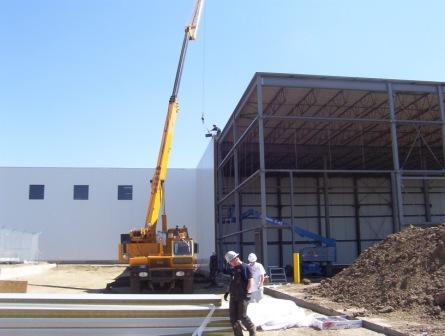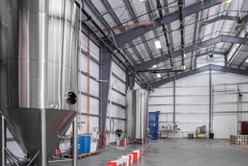
Stop heat conductance with a correctly installed IMP
Insulated metal panels (IMPs) are the preferred method of construction for buildings in which refrigerated or other low temperature-controlled interior environments are required. One reason for this is because they have the highest insulating value per inch of all metal wall insulating products. IMPs’ continuous insulation values and built-in thermal breaks can significantly lower a building’s energy costs and overall operating costs, provided they are installed correctly.
 |
Understanding the installation
Jay Smith, vice president of sales, Metl-Span, Lewisville, Texas, stresses the correct installation of IMPs for cold storage applications requires a greater understanding of the following technology than would be needed for non-refrigerated applications:
• Understanding of the lifting and handling requirements for IMPs (which are typically thicker and heavier for cold storage applications).
• Understanding of differential expansion/contraction dynamics (especially between IMPs and framing), and the requirements for minimizing expansion/contraction stress.
• Understanding of heat flow dynamics, and the requirements for minimizing thermal conductance through the wall or roof construction.
• Understanding of the field-installed thermal insulating materials suitable for cold storage applications and the requirements for proper installation.
• Understanding of vapor flow dynamics, and the requirements for minimizing water vapor infiltration through the wall or roof construction.
• Understanding of weather/vapor sealants and membrane materials suitable for cold storage applications, and the requirements for proper installation.
Pre-installation
Before starting the panel installation, the installer must ensure the proper equipment and tools are on hand. Unloading the panel bundles will require a suitable forklift or crane. The equipment must be capable of handling the weight and multiple point pick-up requirements of the panel bundles. Because IMPs for cold storage environments are thicker and heavier than conventional IMPs, use vacuum lifting equipment to move them. “Advancements in vacuum lifters have been a huge help to the IMP contractors,” says Smith. “These vacuum devises can lift panels that weigh as much as 1,200 pounds and have the ability to rotate 360 degrees and have tilting capabilities. These devices can be mounted on forklifts, cranes and other hoisting equipment, making installation much safer and faster.”
 |
Critical barrier control
IMPs are installed using a complete concealed fastener system that typically includes the vapor barrier, air barrier and water barrier on the warm side, or ambient side, of the space. The vapor seals are critical to stopping heat conductance between cold areas and the warmer, ambient side of the wall.
“The effect of proper installation on the long-term viability and performance of IMPs in cold storage or refrigerated environments should be thoroughly understood,” says Steve Mauro, national sales director, cold storage division U.S., Kingspan Insulated Panels North America, Deland, Fla. “Specifically, installation and proper care of the vapor seal and thermal break will be of the utmost importance. When these engineering advances are combined with proper detailing and installation, they prevent heat transference through the metal exterior to metal interior skin.”
In cold storage facilities, the vapor barrier must be installed at the warm side or exterior of the thermal envelope. “In freezer construction, for instance, it is imperative that the vapor barrier below the floor insulation ties into the exterior of the IMP wall at the base condition,” says William Lowery, president of All Weather Insulated Panels, Vacaville, Calif. “For coolers and freezers, the roof exterior vapor barrier, whether IMP or membrane, must tie into the IMP wall at roof-to-wall connections. Without a complete vapor seal, vapor drive will result in condensation or ice formations at the building interior.”
What follows are general details provided by Metl-Span showing typical cold-storage IMP vapor barrier installation steps. Because of the many variations of applications and construction conditions, these may vary from the project’s actual conditions. Always reference the project’s installation drawings and project specifications.
• For the vapor barrier alignment, at the corners temporarily set and align the corner trim into position on the wall panels. Mark the position of the corner trim’s outer edges on the panel face at the base and head of the panel.
• At the eaves and rakes, temporarily set and align the eave or rake flashing into position along the edge of the roof. Mark the position of the flashing’s bottom edge on the wall panels at each corner and at intermediate locations along the wall.
• Extend the chalk lines between the marks to provide for alignment of the vapor barrier during its installation.
• For the tape sealant, at the wall corners, apply the tape sealant continuously along the wall panel surface at 1/4-inch from the chalk line. Extend the tape sealant from the bottom edge of the wall panels to above the chalk line along the eave/rake.
• At the eaves and rakes, apply the tape sealant continuously along the wall panel surface at 1/4-inch above the chalk line. Continue the sealant around the corners and lap the wall corner tape sealants.
• For the vapor barrier membrane, install the corner membranes first, and then install the eave/rake membranes to lap over the top of the corner membrane.
• Cut the membranes to fit flush with the outer edges of the tape sealants, and uniformly adhere the edges of the membrane to the tape sealant.
• Lap and seal the membrane at the corners and splices.
 |
For best results
For best results and accurate advice, always consult a company specializing in the management and installation of low-temperature IMP installation that has documented experience. Always look for an installer approved and trained by the manufacturer. All members of the field crew must have a thorough understanding of cold storage details, including transitions, and be experienced in the proper installation of trim and vapor barriers.
“There are so many considerations that have to be addressed like thermal efficiency, structural design, thermal stress factors, panel connections, flashing assemblies and vapor control just to mention a few,” says Smith. “The customer is responsible to ensure that the building designer, installation contractor and on-site quality control inspector are experienced and competent to conduct correct cold storage building construction, and the proper application and installation of IMPs.”
Get help from the manufacturer too. “At Kingspan, we make recommendations for types of small tools best used for cutting, hoisting and installing cold-storage IMPs,” says Mauro. “Installers should always consult the manufacturer about any special tools or requirements prior to beginning installation.”





